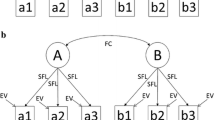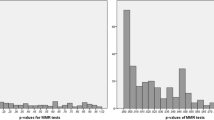Abstract
During the past two decades, organizational researchers have combined the techniques of meta-analysis (MA) and structural equation modeling (SEM) with the intention of building on the strengths of these approaches to address unique research questions. Though these integrative analyses can involve the use of SEM to conduct MA, the focus of the current article is on those situations in which meta-analytic correlations are used as input for testing structural models not previously evaluated in any single, primary study. The purpose of this paper is to provide a summary of the salient choices that must be made by researchers interested in integrating these methods and offering several recommendations for those undertaking such analytic strategies. Overall, the combination of MA and SEM offers researchers unique opportunities, but caution must be exercised when drawing inferences from results.

Similar content being viewed by others
Notes
The integration of MA and SEM could also take the form of using SEM to conduct MA. Cheung (2008) provides a discussion of this.
At the time of the preparation of this manuscript, the current version of the program works with generating code for use with OpenMx software.
References
Barrett, P. (2007). Structural equation modeling: Adjudging model fit. Personality and Individual Differences, 42, 815–824.
Burke, M. J., & Landis, R. S. (2003). Methodological and conceptual challenges in conducting and interpreting meta-analyses. In K. R. Murphy (Ed.), Validity generalization: A critical review (pp. 287–309). Mahwah, NJ: Erlbaum.
Card, N. A. (2012). Applied meta-analysis for social science research. New York: Guilford Press.
Cheung, M. W. L. (2008). A model for integrating fixed-, random-, and mixed-effects meta-analysis into structural equation modeling. Psychological Methods, 13, 182–202.
Cheung, M. W. L. (2009). TSSEM: A LISREL syntax generator for two-stage structural equation modeling (Version 1.11) [Computer software and manual]. Retrieved from Jan 25, 2013 http://courses.nus.edu.sq/course/psycwlm/internet/tssem.zip.
Cheung, M. W. L., & Chan, W. (2005). Meta-analytic structural equation modeling: A two-stage approach. Psychological Methods, 10, 40–64.
Cheung, M. W. L., & Chan, W. (2009). A two-stage approach to synthesizing covariance matrices in meta-analytic structural equation modeling. Structural Equation Modeling, 16, 28–53.
Christian, M. S., Bradley, J. C., Wallace, J. C., & Burke, M. J. (2009). Workplace safety: A meta-analysis of the roles of person and situation factors. Journal of Applied Psychology, 94, 1103–1127.
Colquitt, J. A., LePine, J. A., & Noe, R. A. (2000). Toward an integrative theory of training motivation: A meta-analytic path analysis of 20 years of research. Journal of Applied Psychology, 85, 678–707.
Conway, J. M., & Lance, C. E. (2010). What reviewers should expect from authors regarding common method bias in organizational research. Journal of Business and Psychology, 25, 325–334.
Cortina, J. M., Chen, G., & Dunlap, W. P. (2001). Testing interaction effects in LISREL: Examination and illustration of available procedures. Organizational Research Methods, 4, 324–360.
Earnest, D. R., Allen, D. G., & Landis, R. S. (2011). A meta-analytic path analysis of the mechanisms linking realistic job previews and turnover. Personnel Psychology, 64, 865–897.
Hoyle, R. H. (2012). Model specification in structural equation modeling. In R. H. Hoyle (Ed.), Handbook of structural equation modeling. New York: Guilford Press.
Hunter, J. E., & Schmidt, F. L. (1990). Methods of meta-analysis. Newbury Park, CA: Sage.
Jackson, D. L. (2003). Revisiting sample size and number of parameter estimates: Some support for the N:q hypothesis. Structural Equation Modeling, 10, 128–141.
Johnson, R. E., Rosen, C. C., & Chang, C. (2011). To aggregate or not to aggregate: Steps for developing and validating higher-order multidimensional constructs. Journal of Business and Psychology, 26, 241–248.
Kerr, N. L. (1998). HARKing: Hypothesizing after the results are known. Personality and Social Psychology Review, 2, 196–217.
Klein, H. J., Wesson, M. J., Hollenbeck, J. R., Wright, P. M., & DeShon, R. P. (2001). The assessment of goal commitment: A measurement model meta-analysis. Organizational Behavior and Human Decision Processes, 85, 32–55.
Kline, R. B. (2011). Principles and practice of structural equation modeling (3rd ed.). New York: Guilford Press.
Kline, R. B. (2012). Assumptions in structural equation modeling. In R. H. Hoyle (Ed.), Handbook of structural equation modeling. New York: Guilford Press.
MacCallum, R. C. (1986). Specification searches in covariance structure modeling. Psychological Bulletin, 100, 107–120.
MacKinnon, D. P., Coxe, S., & Baraldi, A. N. (2012). Guidelines for the investigation of mediating variables in business research. Journal of Business and Psychology, 27, 1–14.
Maruyama, G. M. (1998). Basics of structural equation modeling. Thousand Oaks, CA: Sage.
Oswald, F. L., & Johnson, J. W. (1998). On the robustness, bias, and stability of statistics from meta-analysis of correlation coefficients: Some initial Monte Carlo findings. Journal of Applied Psychology, 83, 164–178.
Ployhart, R. E., & Ward, A. K. (2011). The “quick start guide” to conducting and publishing longitudinal research. Journal of Business and Psychology, 26, 413–422.
Preacher, K. J., & Coffman, D. L. (2006, May). Computing power and minimum sample size for RMSEA [Computer software]. Retrieved from Jan 25, 2013 http://quantpsy.org/.
Robbins, S. B., Oh, I., Le, H., & Button, C. (2009). Intervention effects on college performance as mediated by motivational, emotional, and social control factors: Integrated meta-analytic path analyses. Journal of Applied Psychology, 94, 1163–1184.
Shanock, L. R., Baran, B. E., Gentry, W. A., Pattison, S. C., & Heggestad, E. D. (2010). Polynomial regression with response surface analysis: A powerful approach for examining moderation and overcoming limitations of difference scores. Journal of Business and Psychology, 25, 543–554.
Silvia, E. S. M., & MacCallum, R. C. (1988). Some factors affecting the success of specification searches in covariance structure modeling. Multivariate Behavioral Research, 23, 297–326.
Stone-Romero, E. F., & Rosopa, P. J. (2008). The relative validity of inferences about mediation as a function of research design characteristics. Organizational Research Methods, 11, 326–352.
Tonidandel, S., & Lebreton, J. M. (2011). Relative importance analysis: A useful supplement to regression analysis. Journal of Business and Psychology, 26, 1–9.
Valentine, J. C., Pigott, T. D., & Rothstein, H. R. (2010). How many studies do you need?: A primer on statistical power for meta-analysis. Journal of Educational and Behavioral Statistics, 35, 215–247.
Viswesvaran, C., & Ones, D. S. (1995). Theory testing: Combining psychometric meta-analysis and structural equations modeling. Personnel Psychology, 48, 865–885.
Author information
Authors and Affiliations
Corresponding author
Rights and permissions
About this article
Cite this article
Landis, R.S. Successfully Combining Meta-analysis and Structural Equation Modeling: Recommendations and Strategies. J Bus Psychol 28, 251–261 (2013). https://doi.org/10.1007/s10869-013-9285-x
Published:
Issue Date:
DOI: https://doi.org/10.1007/s10869-013-9285-x




